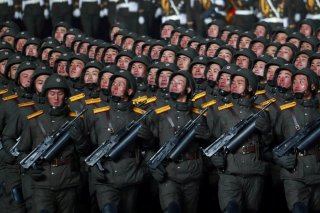Wanna Know Why North Korea Is A Military Powerhouse? One Word: Russia
How did North Korea become a major regional power, both in terms of its nuclear arsenal and by conventional military metrics?
Here's What You Need to Remember: There is little historical question that North Korea’s defense industry was not only founded and sustained by direct Soviet military-technological transfers over a period of half a century, but that Soviet and Soviet-licensed hardware continues to be a pillar of North Korea’s current military equipment roster. However, the USSR’s Russian successor has been much less willing to act as a military beneficiary of Pyongyang.
As North Korea continues on a missile test spree described by Pyongyang as a “solemn warning” to South Korea, the specter of open military conflict on the Korean peninsula continues to loom large despite Washington’s ongoing efforts to promote North-South reconciliation.
But how did North Korea become a major regional power, both in terms of its nuclear arsenal and by conventional military metrics?
Prior reporting has focused on the peculiarities of the North Korean war economy; in particular, the Songun or “military first” policy that holds up the army as the central organizing pillar of North Korean society. Much of the answer, however, lies in external aid; for one, North Korea considerable military strength would be utterly unsustainable were it not for a steady stream of Chinese economic subsidies. But there is an even more direct aspect of external aid to North Korea that goes largely unnoticed in contemporary defense commentary: North Korea’s defense industry was built on, and is today predominantly composed of, Soviet arms and equipment.
The Democratic People's Republic of Korea emerged in 1948 as the byproduct of a postwar arrangement that saw Korea divided along the infamous 38th parallel, with the North and South being absorbed into the Soviet and Western spheres of influence respectively. Joseph Stalin’s politburo wasted no time in building up the North Korean military, infusing it with 200 million rubles’ worth of military aid between 1949 and 1952. Initial Soviet shipments consisted of 37 T-34 tanks, tens of thousands of small firearms, mortars, Il-10 and Yak-9 fighters, and several different kinds of howitzers; around 40,00 Soviet military personnel were dispatched to not only train the burgeoning North Korean forces but to provide them with combat support and technical expertise during the Korean War of 1950-1953.
Following a brief diplomatic pall during the Khruschev period, Soviet military-technological transfers to North Korea resumed in full force over the mid-1960s and continued into the mid-1980’s. North Korea’s ground forces received over one thousand T-55 main battle tanks (a portion of which is thought to be in use to this day) spread out over several shipments, as well as a T-62 production license that resulted in five domestically produced variants known as the Chonma-ho.
North Korea has slowly transitioned away from direct Soviet transfers in favor of domestic production, but Soviet DNA continues to permeate Pyongyang’s defense industry; for instance, their current flagship Pokpung-ho tank borrows heavy design influences from the T-62 and T-72, and reportedly even the newer Russian T-90.
Meanwhile, in the small arms department, North Korea’s standard-issue Type 58 and 68 assault rifles are based on Kalashnikov’s AK-47 and AKM licenses respectively. As discussed by The National Interest, even their latest Type 88 rifle is clearly modeled after the Soviet-era AK-74. By the same token, a great swathe of North Korea’s air force consists of over 200 Soviet and Russian fighters, notably including the MiG-29, Il-28, and Su-25. Their current air defense force is almost exclusively composed of Soviet and Russian S-200, S-125, and S-75 surface-to-air missile systems.
There is little historical question that North Korea’s defense industry was not only founded and sustained by direct Soviet military-technological transfers over a period of half a century, but that Soviet and Soviet-licensed hardware continues to be a pillar of North Korea’s current military equipment roster. However, the USSR’s Russian successor has been much less willing to act as a military beneficiary of Pyongyang; in the 21st century, that role has instead fallen to a People’s Republic of China that has been increasingly active in asserting its geopolitical interests in the East Asia region.
Mark Episkopos is a frequent contributor to The National Interest and serves as research assistant at the Center for the National Interest. Mark is also a PhD student in History at American University. This article first appeared in 2019 and is reprinted here due to reader interest.
Image: Reuters

